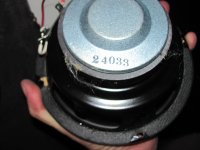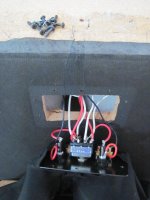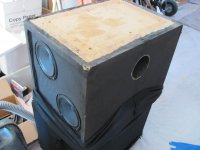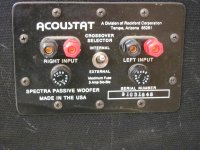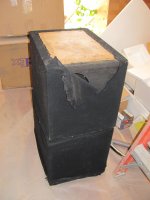I secured enough Acoustat panels and 4 interfaces to build another pair of the Model 6 speakers.
Can someone here provide a woodwork plan?
If there ever was any drawings of the Model 6 frame (I never saw one), they did not survive the demise of the company. Best bet is to copy a 2+2 frame and reduce the angle between panels to about 3-4 degrees.
If there ever was any drawings of the Model 6 frame (I never saw one), they did not survive the demise of the company. Best bet is to copy a 2+2 frame and reduce the angle between panels to about 3-4 degrees.
Thanks for the quick reply.
Could you please provide any info about the 2+2 frame?
Thanks for the quick reply.
Could you please provide any info about the 2+2 frame?
Sorry, I should have been more clear. There are NO surviving frame drawings from Acoustat except for the Spectra series, which are sufficiently different to not be of much help in building a Model 6.
What I meant was to LOOK at a 2+2 frame and copy it. Lacking that, you may be able to find some grille-off photos on the web. Amazing how many Acoustat photos are available. In any case, considerable design and woodworking ability will be required.
If you are interested in speaker cable for your Acoustats, you want a design that minimizes inductance and resistance to keep from rolling off the top end.Is there a speaker cable type that makes a difference? How about speaker gauge?
That being said, unless your runs are unusually long there isn't going to be that much effect relative to common "zip-cord" speaker wire.
Here are links to 2 DIY cable designs that have low measured inductance.
Low-Inductance DIY Braided Hi-Fi Speaker Cables
Jazzman's DIY Electrostatic Loudspeaker Page: Cross-Connected Coax Speaker Cables
measurements for the cross-linked cables at the bottom of this page:
Cross Coax Cables Design vs Zip Cord | Audioholics
As AcoustatAnswerMan already mentioned, this idea will work just fine and reduce the load on the amplifiers.I'm thinking of splitting the primary transformer inputs and driving each one with a separate channel of amplifier... Do you know if the secondaries of the transformers interact enough to cause any EMF or other "stress" to the output of the amps if they are driven this way?
HOWEVER, it is important to understand that since the primaries are tightly coupled at midrange and lower frequencies you need to make sure both amplifiers are connected properly and driving their respective primary with the same signal level. In a situation where one channel wasn't receiving a signal, the amplifier would effectively be shorting the primary it is connected to and that short would be coupled to the other primary. So the other amplifier (the one with a signal) would be trying to drive a short.
In summary, if you decide to use this approach, make sure both amplifiers are working and adjusted to the same output level.
...."Happy holidays"......Andy....bolserst....an too all others ...that help us keep these great ESL working.......good time to all.....
long live Acoustats.........
long live Acoustats.........
Hi Folks,
I have an issue with my Spectra-22 panels that I could use some feedback on! As long as I have had these I have had a bit of an issue with the Left Bass Panel discharging (arcing?) at high volumes! It sounds like a rattle or static in the upper part of the Bass Panel.
With the work Roy Esposito did on my Interfaces, I believe I am now driving the panels more efficiently and effectively. And so now that effect is presenting itself at lower volumes.
What’s curious to me is if I switch from Full Range to Sub-bypass it seems to go away. I guess without the added Bass Extension I’m not over driving the Panel? But what is curious is the Bass seems richer! I've heard that the Sub-Bypass doesn't stress the membrane as significantly so the sound is "different". Seems to be what I am hearing.
So I have lots of questions but first, what damage might have taken place or will take place with the arcing. What options do I have to diagnose/repair what might be happening. Should I have the panels worked by someone who knows what they are doing (more so than I) and if so who might be "da bomb" with these things?
What are your thoughts DIY'ers?
In the meantime I'll get back to listening in Sub-bypass as I'm really diggin' the beauty Roy has bestowed on these Spectra-22's!!! 😀
I have an issue with my Spectra-22 panels that I could use some feedback on! As long as I have had these I have had a bit of an issue with the Left Bass Panel discharging (arcing?) at high volumes! It sounds like a rattle or static in the upper part of the Bass Panel.
With the work Roy Esposito did on my Interfaces, I believe I am now driving the panels more efficiently and effectively. And so now that effect is presenting itself at lower volumes.
What’s curious to me is if I switch from Full Range to Sub-bypass it seems to go away. I guess without the added Bass Extension I’m not over driving the Panel? But what is curious is the Bass seems richer! I've heard that the Sub-Bypass doesn't stress the membrane as significantly so the sound is "different". Seems to be what I am hearing.
So I have lots of questions but first, what damage might have taken place or will take place with the arcing. What options do I have to diagnose/repair what might be happening. Should I have the panels worked by someone who knows what they are doing (more so than I) and if so who might be "da bomb" with these things?
What are your thoughts DIY'ers?
In the meantime I'll get back to listening in Sub-bypass as I'm really diggin' the beauty Roy has bestowed on these Spectra-22's!!! 😀
Hi Folks,
I have an issue with my Spectra-22 panels that I could use some feedback on! As long as I have had these I have had a bit of an issue with the Left Bass Panel discharging (arcing?) at high volumes! It sounds like a rattle or static in the upper part of the Bass Panel.
With the work Roy Esposito did on my Interfaces, I believe I am now driving the panels more efficiently and effectively. And so now that effect is presenting itself at lower volumes.
What’s curious to me is if I switch from Full Range to Sub-bypass it seems to go away. I guess without the added Bass Extension I’m not over driving the Panel? But what is curious is the Bass seems richer! I've heard that the Sub-Bypass doesn't stress the membrane as significantly so the sound is "different". Seems to be what I am hearing.
So I have lots of questions but first, what damage might have taken place or will take place with the arcing. What options do I have to diagnose/repair what might be happening. Should I have the panels worked by someone who knows what they are doing (more so than I) and if so who might be "da bomb" with these things?
What are your thoughts DIY'ers?
In the meantime I'll get back to listening in Sub-bypass as I'm really diggin' the beauty Roy has bestowed on these Spectra-22's!!! 😀
At some point in loudness, it is normal for the panels to exhibit a rattling, fluttering or even arcing noise. This indicates the diaphragms have reached their excursion limit. However, no damage is occurring to the panels under these conditions (the same cannot necessarily be said of other brands of ESL's).
It is entirely expected that the noise would reduce or go away completely when using the 'Above 100Hz' setting. Bass notes cause the most excursion of the diaphragm, and therefore aggravate the situation. Eliminating most of the program material at low frequencies relieves the speaker from large excursions.
The fact that one speaker (or even just one panel) is making the noise before the others may indicate a slight loss of tension in the Mylar diaphragm. This can be remedied by applying heat in the form of an industrial heatgun, keeping the source of heat several inches away from the panel and constantly moving. This should be done with the speaker discharged, and may need to be repeated in order for it to be completely effective. In can be done with the grille cloth in place. This procedure has been discussed several times within this thread...go slow and keep in mind that it is possible to overdo it and damage the Mylar.
Got it Andy and thanks... it makes me feel better that there isn't anything wrong with the wiring and that this is a panel tension issue! I'll leave them in Sub-bypass mode and think about opening them up some day to heat the panel. In the meantime, I'll get back to Appreciating the "Magic of Roy"!
I just found a pair of Acoustat Spectra 44 with the updated interface.
Both speakers have one panel that is silent, and another that has less output than the others.
Would you be able to point me in the right direction with regards to troubleshooting these please?
Both speakers have one panel that is silent, and another that has less output than the others.
Would you be able to point me in the right direction with regards to troubleshooting these please?
Make sure all the panel wires (for spectra, 5 wires per panel, so 20 wires per speaker for 44) are properly connected to their respectively colored pins from the other panels on same speaker, and then check if properly connected into interface ...
ie - all the black labeled wires for the four panels are connected together and securely soldered onto the black connector pin, then make sure the pin is securely in the black pin receptor on PCB in interface. Then check the white wires, blue, yellow, and finally red (bias wires). You can start here.
I have had second hand Acoustats purchased locally that had low output or dead panels caused by the stator wires (or red bias wires) completely disconnected from the PCB in interface. Simple fix, and the best place to start troubleshooting.
ie - all the black labeled wires for the four panels are connected together and securely soldered onto the black connector pin, then make sure the pin is securely in the black pin receptor on PCB in interface. Then check the white wires, blue, yellow, and finally red (bias wires). You can start here.
I have had second hand Acoustats purchased locally that had low output or dead panels caused by the stator wires (or red bias wires) completely disconnected from the PCB in interface. Simple fix, and the best place to start troubleshooting.
I just found a pair of Acoustat Spectra 44 with the updated interface.
Both speakers have one panel that is silent, and another that has less output than the others.
Would you be able to point me in the right direction with regards to troubleshooting these please?
Congratulations on your acquisition of a great speaker. The suggestions above are all good, and would be worthwhile to check.
However, keep in mind that the Spectra series is a variable-area design, where only a small half-panel width plays full range, a greater area plays mids and lows, and the remainder of the area plays lows only. So your observations, if you don't know what to expect, could be the description of a properly working speaker. If the speaker sounds tonally balanced, from lows to highs, then your speaker is working exactly as it should.
Also keep in mind that the Spectra is designed as a right and left pair, and care should be taken to get the left and right speaker oriented correctly for proper imaging. For the Model 44, the full range segment should be closer to the inner edge of each speaker. That is, full range should be playing from closer to the right edge of the left speaker, and from closer to the left edge of the right speaker.
I suspect there is nothing wrong at all with your speaker. Enjoy!
The seller had a change of heart and decided to get rid of his 2+2's instead.
I still passed on the recommendations generously offered to me here. Thanks again guys.
I still passed on the recommendations generously offered to me here. Thanks again guys.
I have two pairs of 2+2 - a great set of speakers. You should not hesitate to jump on them if price is right.
Would I rather have spectra 44 (or 4400)? Absolutely.
Would I rather have spectra 44 (or 4400)? Absolutely.
It was the first time that I had seen and listened to a pair of the large Acoustats, and I was surprised how tall they were!
Unfortunately, we are moving to a tiny house, and my Hartleys and all large speaker days are over. Monkey coffins are in my future I'm afraid.
Unfortunately, we are moving to a tiny house, and my Hartleys and all large speaker days are over. Monkey coffins are in my future I'm afraid.
Hi Andy, I just bought a pair of SPW-1's that need some help. What speaker was used in these (I have heard peerless)? And where is the crossover located?
Attachments
The crossover is located in the woofer box...somewhere. The SPW was assembled at Rockford's Carbonneau speaker-manufacturing facility so I never actually looked inside one.
The woofers were custom designed and manufactured at Carbonneau for the SPW, and no, I don't have any spec's on it. Since you have two SPW's, and they're really designed for stereo-use, perhaps you could use one for parts to get one in good working order.
The woofers were custom designed and manufactured at Carbonneau for the SPW, and no, I don't have any spec's on it. Since you have two SPW's, and they're really designed for stereo-use, perhaps you could use one for parts to get one in good working order.
- Home
- Loudspeakers
- Planars & Exotics
- Acoustat Answer Man is here
